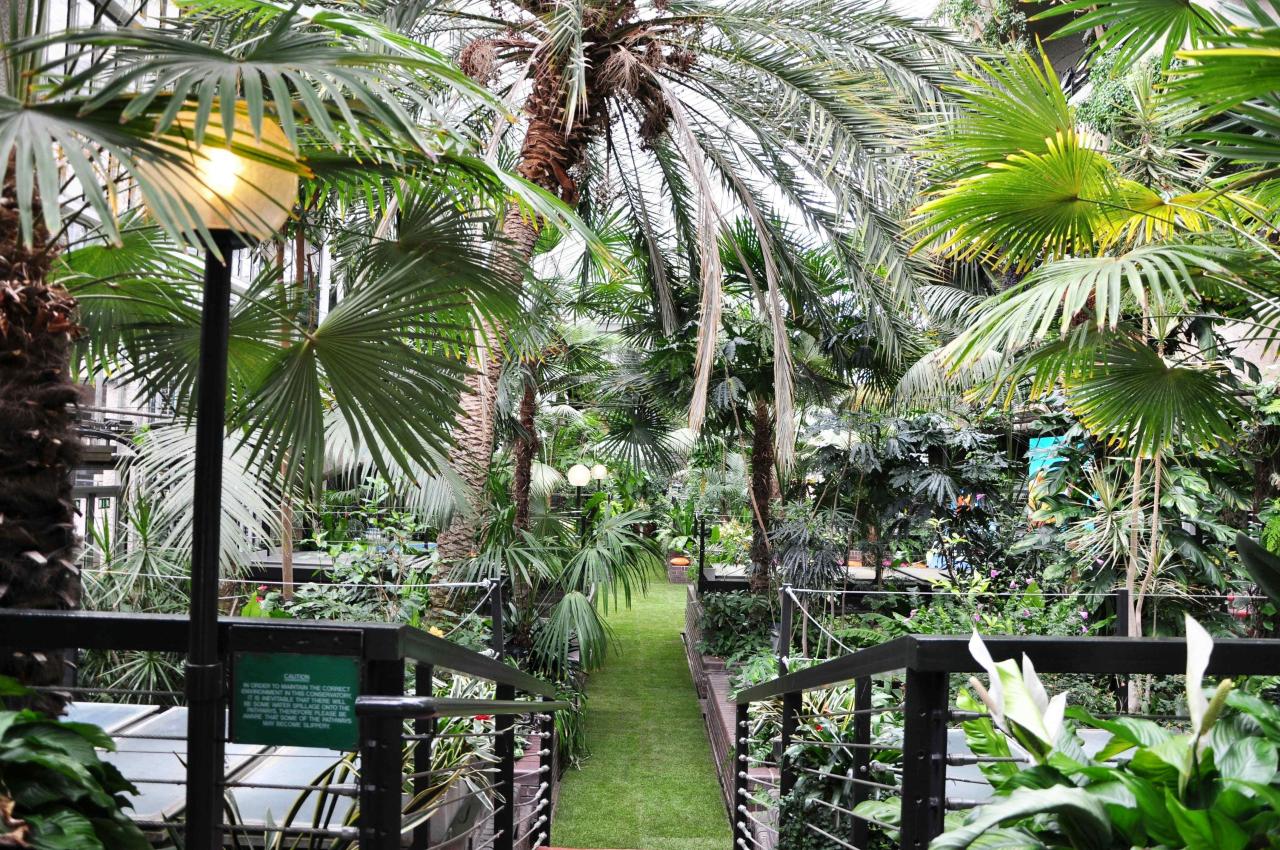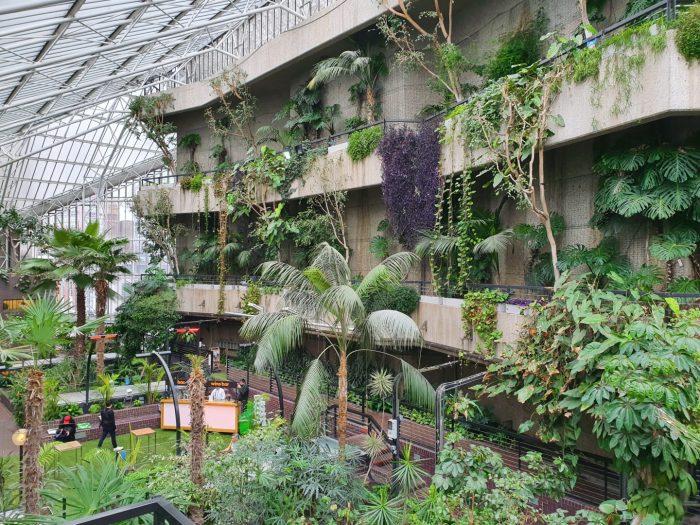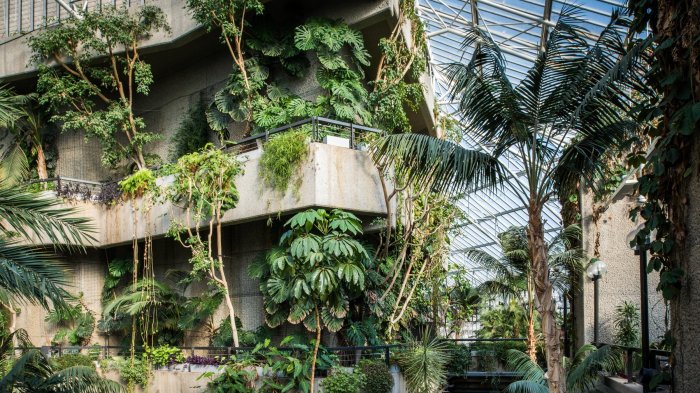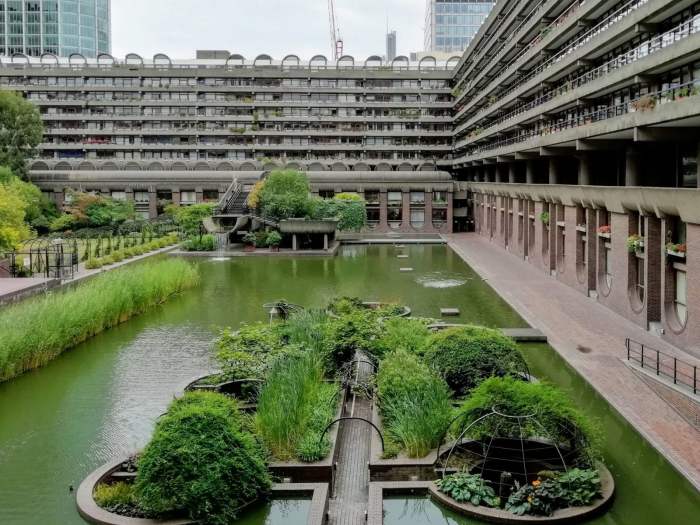Step into the Barbican Conservatory, a captivating haven where architectural brilliance meets botanical diversity. This iconic glasshouse, nestled within the heart of London’s Barbican Estate, offers a captivating journey through a world of vibrant flora and horticultural marvels.
From its striking geometric design to its meticulously curated plant collection, the Barbican Conservatory stands as a testament to human ingenuity and the beauty of nature. Prepare to be mesmerized as we delve into its architectural features, explore its diverse plant life, and uncover its role in urban greening and community engagement.
Barbican Conservatory’s Architectural Features

The Barbican Conservatory is renowned for its unique architectural design, which sets it apart from other conservatories. Its striking geometric structure, innovative use of materials, and integration with the surrounding Barbican Estate contribute to its iconic appearance.
The conservatory’s geometric design is characterized by a series of intersecting paraboloid domes, creating a distinctive undulating roofline. This design not only provides an aesthetically pleasing form but also allows for maximum natural light penetration, essential for the plants housed within.
The conservatory’s structure is composed of a steel frame clad with aluminum panels and glass. The use of aluminum, a lightweight and durable material, allows for the creation of the large, expansive glazed surfaces that characterize the conservatory. The transparency of the glass provides unobstructed views of the interior, inviting visitors to admire the diverse plant life from multiple perspectives.
Materials and Design Significance
The choice of materials in the conservatory’s design was carefully considered to enhance its functionality and aesthetic appeal. Aluminum’s strength and lightness make it an ideal material for the conservatory’s frame, allowing for the creation of the complex geometric forms without compromising structural integrity.
The glass cladding not only provides transparency but also allows for maximum light penetration, essential for plant growth. The use of double-glazed units helps regulate temperature and humidity levels within the conservatory, creating an optimal environment for the plants.
The combination of aluminum and glass creates a visually striking contrast, with the metallic sheen of the aluminum complementing the transparency of the glass. This contrast adds to the conservatory’s iconic appearance, making it a recognizable landmark within the Barbican Estate.
Conservatory’s Plant Collection and Diversity

The Barbican Conservatory houses a diverse collection of over 2,000 plant species from around the world, creating a visually stunning and immersive experience for visitors. The plants are organized into different zones based on their geographical origins, including tropical rainforest, desert, and Mediterranean climates.
Conservation Efforts and Research
The conservatory actively participates in conservation efforts and research projects focused on preserving rare and endangered plant species. They collaborate with botanical gardens worldwide to exchange knowledge and best practices for plant conservation. Additionally, the conservatory conducts research on plant physiology, ecology, and genetics to contribute to the understanding and protection of plant diversity.
Conservatory’s Educational and Community Programs

The Barbican Conservatory serves as a hub for environmental education and community engagement, offering a diverse range of programs and initiatives.
The conservatory provides educational programs tailored to all ages, including guided tours, workshops, and interactive activities. These programs aim to foster a deep understanding of plant life, ecology, and the importance of biodiversity.
Outreach Initiatives
The conservatory actively engages with the local community through outreach initiatives, such as community gardening projects, plant donation programs, and educational partnerships with schools and organizations.
Environmental Awareness and Sustainability
The Barbican Conservatory plays a pivotal role in promoting environmental awareness and sustainability. Through its educational programs and outreach initiatives, the conservatory educates visitors about the significance of plant conservation, sustainable gardening practices, and the impact of human activities on the environment.
Conservatory’s Role in Urban Greening and Well-being

Amidst the towering skyscrapers and bustling streets of London, the Barbican Conservatory stands as a verdant oasis, contributing significantly to urban greening and the well-being of city dwellers.
The conservatory’s diverse collection of plants from around the world not only enhances the city’s biodiversity but also creates a vibrant and calming green space within the dense urban environment. Studies have shown that exposure to greenery can reduce stress, improve mood, and boost cognitive function.
The Barbican Conservatory, located in the heart of London, is a lush oasis amidst the bustling city. While it’s an enchanting place to explore, the allure of Bern , the charming capital of Switzerland, beckons. Bern offers a harmonious blend of history, culture, and natural beauty, making it a perfect complement to the serene ambiance of the Barbican Conservatory.
Returning to the conservatory, one can’t help but appreciate the intricate beauty of its diverse plant life, which creates a tranquil haven in the urban jungle.
Benefits of a Green Oasis in a Dense Urban Environment, Barbican conservatory
- Reduced air pollution: Plants absorb pollutants and release oxygen, contributing to cleaner air in the city.
- Enhanced biodiversity: The conservatory provides a habitat for a wide variety of insects, birds, and other wildlife, increasing the city’s biodiversity.
- Improved mental health: Spending time in green spaces has been linked to improved mental health, reduced anxiety, and increased feelings of well-being.
Impact on Visitors’ Well-being and Mental Health
The Barbican Conservatory offers visitors a serene and restorative retreat from the hustle and bustle of city life. Its lush greenery, exotic plants, and tranquil atmosphere create a sanctuary where visitors can relax, de-stress, and connect with nature.
Research has demonstrated that spending time in nature can lower blood pressure, reduce stress hormones, and improve sleep quality. The conservatory’s indoor rainforest environment provides a unique opportunity for visitors to experience the calming and rejuvenating effects of nature within the heart of the city.
Conservatory’s Historical and Cultural Significance

The Barbican Conservatory is a renowned landmark with a rich history and cultural significance. Its origins date back to the post-World War II reconstruction of London, when the Barbican Estate was conceived as a visionary urban renewal project.
In 1969, the conservatory was designed by architects Chamberlin, Powell, and Bon in collaboration with horticulturalists. It opened to the public in 1982, offering a tranquil oasis amidst the concrete structures of the Barbican Estate.
Barbican Conservatory is a beautiful place to visit in London, and it’s home to a variety of exotic plants. If you’re looking for a day trip from London, Arbroath is a great option. It’s a small town on the east coast of Scotland, and it’s home to the Arbroath Abbey, which was founded in 1178.
After exploring Arbroath, you can head back to London and visit the Barbican Conservatory.
Architectural Legacy
The conservatory’s unique architectural design is a testament to the Brutalist style popular during its construction. Its geometric shapes and exposed concrete create a striking contrast to the surrounding buildings, making it a recognizable landmark.
The conservatory’s interior is equally impressive, with a vast, open-plan layout that allows visitors to immerse themselves in the diverse plant collection. The central walkway, lined with cascading plants, leads to a series of smaller, themed gardens, each showcasing a specific plant group.
Horticultural Legacy
The Barbican Conservatory is home to a diverse collection of over 2,000 plant species from around the world. The collection includes rare and endangered plants, as well as common favorites. The conservatory’s horticulturists work diligently to maintain the collection and educate visitors about the importance of plant conservation.
The conservatory’s educational programs play a vital role in fostering a love of nature and horticulture among visitors of all ages. Guided tours, workshops, and interactive exhibits provide opportunities for visitors to learn about plant science, ecology, and the role of plants in urban environments.
Cultural Significance
The Barbican Conservatory has become an integral part of the local community. It is a popular destination for residents and tourists alike, offering a peaceful escape from the hustle and bustle of city life.
Barbican Conservatory, with its lush tropical gardens and tranquil atmosphere, is a hidden gem in the heart of London. Escape the hustle and bustle of the city and immerse yourself in a serene oasis. While you’re in the area, be sure to explore the vibrant city of Bellingham, WA , known for its scenic beauty, thriving arts scene, and delicious cuisine.
Afterward, return to Barbican Conservatory and continue your exploration of this captivating urban sanctuary.
The conservatory has also been featured in numerous films, television shows, and music videos, showcasing its unique architectural and horticultural appeal to a wider audience.
Conclusion
As we bid farewell to the Barbican Conservatory, we leave with a profound appreciation for its architectural beauty, botanical wonders, and unwavering commitment to environmental stewardship. This urban oasis serves as a beacon of hope, reminding us of the power of nature to uplift, inspire, and foster a sense of well-being in the heart of the city.
Common Queries
What is the Barbican Conservatory?
The Barbican Conservatory is a glasshouse located within the Barbican Estate in London. It houses a diverse collection of plants and serves as a center for educational programs and community engagement.
What makes the Barbican Conservatory’s architecture unique?
The conservatory features a striking geometric design, with a series of glasshouses arranged around a central courtyard. Its innovative use of materials, including glass and steel, creates a light-filled and airy space.
What types of plants are found in the Barbican Conservatory?
The conservatory houses a diverse collection of plants from around the world, including tropical rainforest species, Mediterranean plants, and desert succulents. It is known for its extensive collection of orchids and carnivorous plants.
What educational programs does the Barbican Conservatory offer?
The conservatory offers a range of educational programs for all ages, including guided tours, workshops, and talks. These programs focus on topics such as plant science, biodiversity, and environmental sustainability.
How does the Barbican Conservatory contribute to urban greening?
The conservatory serves as a green oasis within the dense urban environment of London. It provides a habitat for wildlife, improves air quality, and offers a space for recreation and relaxation.